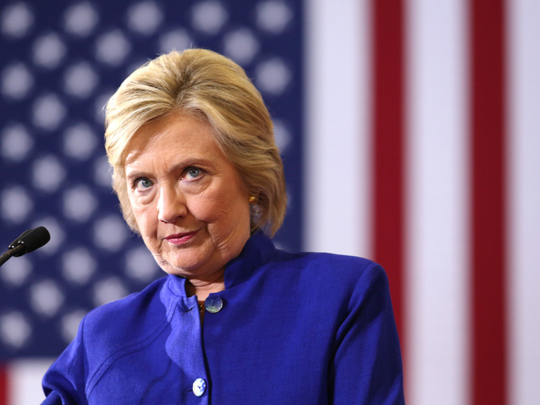
When Hillary Clinton participated in a televised forum on national security and military issues this month, the chairman of the Republican National Committee, Reince Priebus, tweeted that she was “angry and defensive the entire time — no smile and uncomfortable.” Clinton, evidently undaunted by Priebus’ opinion on when she should and shouldn’t smile, tweeted back, “Actually, that’s just what taking the office of president seriously looks like.”
The implication of Priebus’ comment was a familiar one: A woman making stern-looking facial movements must be angry or upset. A man who looks the same, on the other hand, is focusing on the important matters at hand. This is a classic example of a psychological phenomenon that my lab has studied: how people perceive emotion differently in men’s and women’s faces. It’s something for Americans to consider as they watch the first debate between Clinton and Donald Trump on Monday (Tuesday at 5am UAE time).
In one study, published in the journal Emotion, my lab photographed male and female faces in various poses, such as smiles, frowns and widened eyes. Then we showed the photos to test subjects and asked why each face looked as it did. Was the person in the photo being emotional, or just responding to a situation? We found that our subjects were more likely to choose emotion for the photos of women — that is, they believed a woman’s expression was more likely caused by something internal to her — whereas for the photos of men, they were more likely to choose a situation.
To reinforce our findings, we repeated the study using androgynous faces, created on a computer by melding male and female features. We then produced “male” and “female” versions of each face by adding gender-typical hair. Our test subjects, who were unaware of this ruse, were again more likely to attribute an internal, emotional cause to the poses in the faces with female hair, and more likely to attribute a situational cause to the poses in the faces with male hair. Or as we summarised our discovery: “She’s a [expletive], but he’s just having a bad day.” This discrepancy can have serious consequences. As several studies have demonstrated, when women visit emergency rooms complaining of chest pressure and shortness of breath, which are potential signs of heart attack, they are more likely than men to be told the cause is anxiety (that is, something about their emotional disposition), and sent home. Men with the same symptoms tend to receive preventive treatment for heart disease. This is a major reason that women die more frequently of heart attacks than men do
No gender hardwiring
People in many cultures believe that women are more emotional and empathetic, whereas men are more stoic and analytical. Both men and women hold these beliefs, even about themselves. However, when my lab has asked people to record their emotional experiences as they occur in everyday life, we have found no differences between men and women on average. And when scientists have compared the brains of men and women, they have found no gendered hardwiring for emotionality or rationality. In other words, these beliefs about men and women are based on stereotypes.
And it turns out that people are highly protective of these stereotypes. When a woman violates her emotion stereotype, people tend to view her as less likeable and less trustworthy. We see this in the courtroom, for example, when women accuse men of rape or domestic violence. As researchers have shown, if a woman expresses grief on the witness stand, consistent with stereotypes about female emotionality, the judge is more likely to hand down a harsher sentence to the defendant. But if a woman expresses anger, violating the stereotype of a female victim as fearful, passive and helpless, the judge’s sentence tends to be lighter.
Today, these stereotypes are playing out on the US national stage. Polls indicate that Clinton is seen as a more credible candidate than Trump, yet less trustworthy and likeable. This discrepancy is surely rooted, in part, in Clinton’s violations of female stereotypes. When she acts “presidential,” she is seen as harsh and cold. In contrast, when Trump insults his critics or rails against immigrants, many people attribute his anger to the situation (terrorism, the economy) rather than to something about his inner nature. She’s ingenuine; he’s giving voice to the feelings of his fellow Americans.
Most of us recognise gender stereotypes when they’re blatant. But when stereotyping is more subtle, as shown by the facial photo studies, we all succumb and often don’t realise it.
Keep this in mind when you watch the debate. Will you perceive Clinton as running warm and cold, but Trump as responding to the ups and downs of the debate?
When each candidate presses a point, will you see Clinton as being irate but Trump as simply trying to best his opponent? If so, ask yourself: Is it possible that you’re channelling unconscious, cultural biases, and can you rise above them?
— New York Times News Service
Lisa Feldman Barrett, a professor of psychology at Northeastern University, is the author of the forthcoming How Emotions Are Made: The Secret Life of the Brain.









